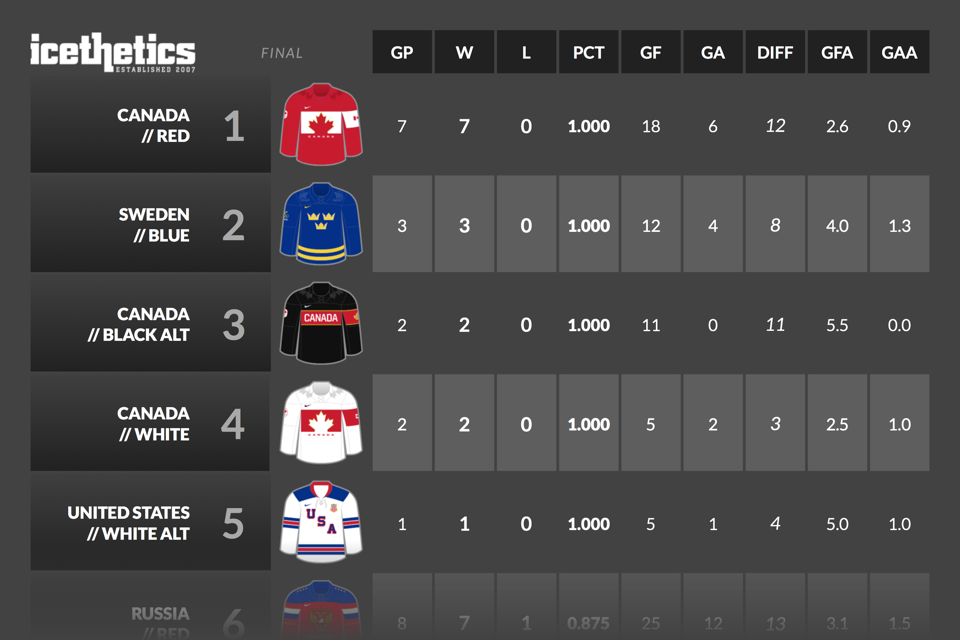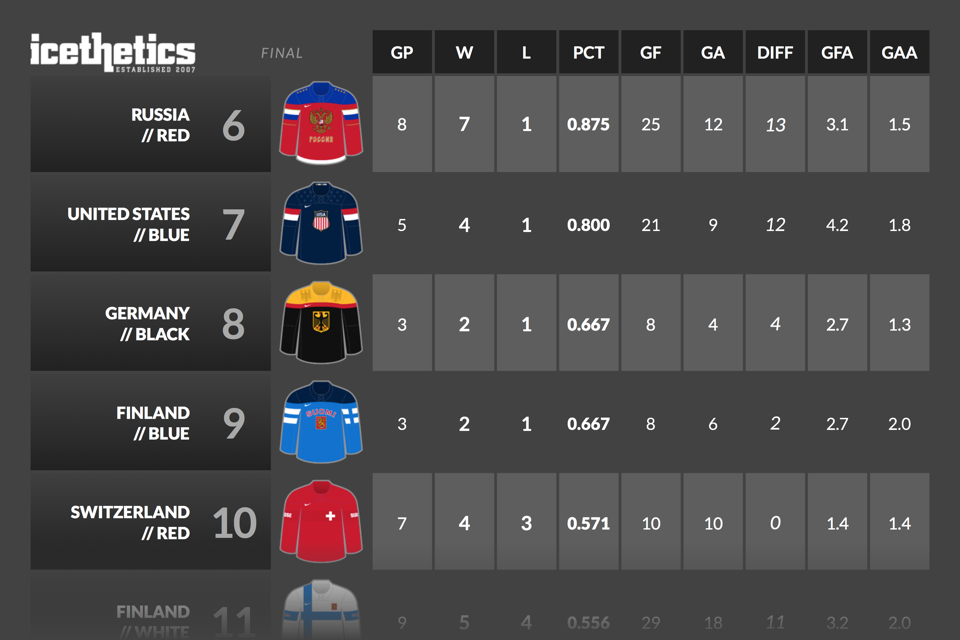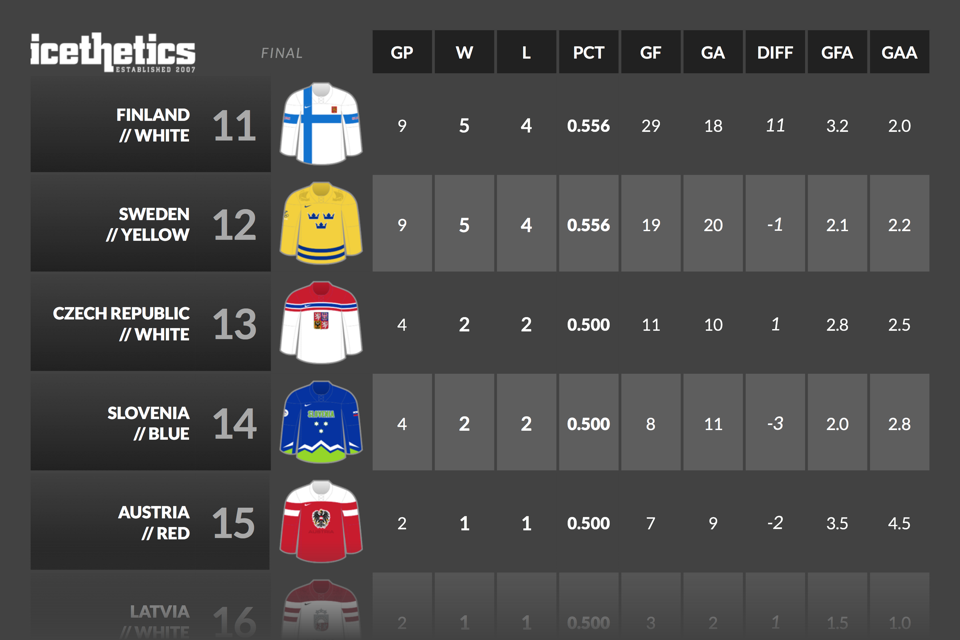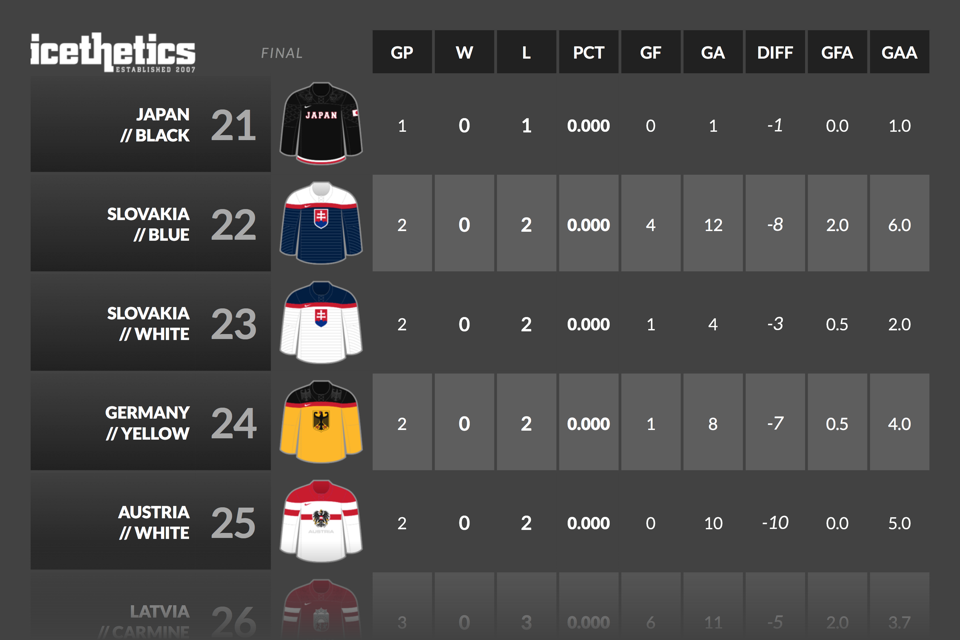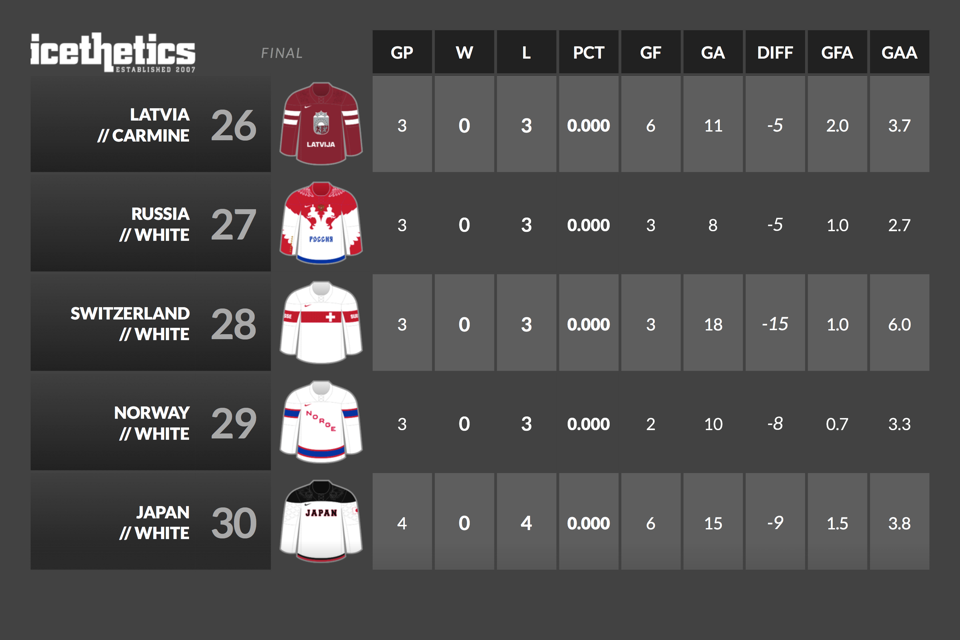Olympic Jerseys by the Numbers
/We love stats. Quantifying athletic accomplishments is as much a pastime as watching a game for some people. Of course, stats are not usually a factor when we talk about uniforms. The color a player is wearing has very little, if anything, to do with his performance on the ice.
Or does it?
While enjoying the men and women's Olympic tournaments in Sochi this week, I started to wonder if certain jerseys were, say, luckier than others. Did teams tend to win or score more while wearing one or the other?
In Sochi, there are only two rinks — nobody's home ice, strictly speaking. Technically, teams are designated "home" and "away" just as their jerseys are. But in reality, matching the "home team" with their "home jersey" was very inconsistent. It has only happened around half the time.
So I started digging into the numbers a little bit and what resulted is below. Enjoy.
2014 Olympic Jersey Standings
The standings above include games in both the men's and women's tournaments.
I'll keep updating this throughout the week. It's a fun, at-a-glance way of seeing how teams are performing in specific uniforms. Anyone can find the regular standings and see Sweden, Russia, Canada and the U.S. are dominating the action. But only here can you see what they've been wearing while doing it.
For a while, Russia topped the list, undefeated in their red jerseys. But that streak ended when the Russian women were shut out by Finland in their Classification Round game. In contrast to the red, the Russians were winless in white.
Ultimately, of course, Canada's red jersey finished first as the team won gold while wearing it — in both the men's and women's tournaments. It was never beaten, and in seven games, allowed only six goals. Canada's Olympic domination meant all three of its jerseys finished in the top four.
Looking at the jersey that finished second, it's hard not to wonder if the gold medal game would have gone different if Sweden was wearing blue.
Keep reading to see how certain colors fared in Sochi.
White jerseys
Obviously, white jerseys are very prevalent. Every team needs light and dark jerseys so they can be distinguished on the ice. Only two teams in Sochi were able to avoid white — Germany and Sweden both opted for yellow jerseys.
But among these 13 white sweaters — including the surprise throwback for Team USA — an unexpected thing happened. Teams did terribly while wearing them. In general, white jerseys were a poor 13-28 (.317) with a -27 goal differential — though the numbers did improve slightly each day toward the end of the Olympics.
Why did teams in white perform so poorly? The white jerseys were designated "home" in theory should've been worn by the higher seeded teams later in the tournament. However, I found that the "home team" wore white only about half the time.
Red jerseys
After white, the most common jersey color was red. Six teams wore red, not including Latvia whose hue is officially "carmine." Red jerseys were 19-7 (.731) with a +15 goal differential. They say red gets you amped up. Maybe it's true.
In fact, as we saw, the same red jersey won gold in both tournaments.
Actually, red may be just as prevalent as white in these Olympics. There is only one country not using the red family in any of its jerseys. That would be Sweden. Every other jersey being used in Sochi has some amount of red. Even Slovenia has their flag on the sleeve of both uniforms.
By the way, the Czech flag jersey counts as red because that's the only one of the three colors that continues onto the back.
Blue jerseys
Five teams wore blue uniforms and there's a little more variety in the shades compared to the red ones above. Blue jerseys are 11-6 (.647) with a +11 goal differential. Things turn a rough turn for the blue sweaters late in the tournament when Finland lost its shot at gold and the U.S. then lost the bronze medal game.
Black jerseys
Now, let's look at the black jerseys. Except for Germany, we're not really accustomed to seeing them at the Olympics. And in truth, we didn't really see them that frequently in Sochi. They're kind of unusual. They finished 4-2 (.667) with an impressive +14 goal differential.
This year, only one black jersey featured in the men's tournament — Canada's alternate. The Canadian men and women each wore it once. It went undefeated, had the highest goals per game average of any jersey, and was the only jersey never to surrender a goal. It's intimidating.
On the women's side, it was a very different story for the teams that wear black. Germany and Japan met Tuesday trying to avoid finishing last place in the tournament. Germany won that game 3-2.
The jersey numbers... literally
Finally, how about we take "jersey numbers" more literally? This one is for the real jersey geeks among us. Every team uses the same lettering for the nameplate (except the USA throwback). But there are five different number styles in use for the tournament.
- First set: Austria, Latvia, Norway, Russia, Slovenia, and the United States (primary only).
- Second set: Germany, Slovakia, Sweden, and Switzerland.
- Third set: Canada and the United States (throwback only).
- Fourth set: Finland and Japan.
- Fifth set: Czech Republic.
I don't know how much more jersey number crunching you can take, so I'm going to quit while I'm ahead. But be aware that this week's Cover Story is a little different from the previous ones. I plan to be updating it all week as games are completed — especially the Jersey Standings at the top.
It'll be interesting to see how the numbers change and whether colorful jerseys continue to outperform white ones. If they do, it'll make betting on the gold medal game a little easier. Probably.
Also, keep an eye out this week for the debut of the new Jersey Galleries. I plan to relaunch it starting with the new Olympic jerseys.

